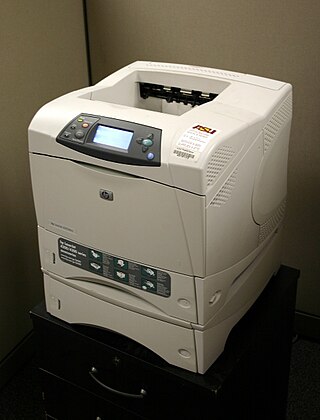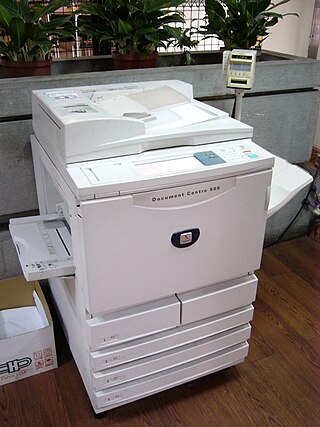Related Research Articles
In digital printing, a page description language (PDL) is a computer language that describes the appearance of a printed page in a higher level than an actual output bitmap. An overlapping term is printer control language, which includes Hewlett-Packard's Printer Command Language (PCL). PostScript is one of the most noted page description languages. The markup language adaptation of the PDL is the page description markup language.

Xerox Holdings Corporation is an American corporation that sells print and digital document products and services in more than 160 countries. Xerox is headquartered in Norwalk, Connecticut, though it is incorporated in New York with its largest population of employees based around Rochester, New York, the area in which the company was founded. The company purchased Affiliated Computer Services for $6.4 billion in early 2010. As a large developed company, it is consistently placed in the list of Fortune 500 companies.
Xerox Network Systems (XNS) is a computer networking protocol suite developed by Xerox within the Xerox Network Systems Architecture. It provided general purpose network communications, internetwork routing and packet delivery, and higher level functions such as a reliable stream, and remote procedure calls. XNS predated and influenced the development of the Open Systems Interconnection (OSI) networking model, and was very influential in local area networking designs during the 1980s.

Laser printing is an electrostatic digital printing process. It produces high-quality text and graphics by repeatedly passing a laser beam back and forth over a negatively charged cylinder called a "drum" to define a differentially charged image. The drum then selectively collects electrically charged powdered ink (toner), and transfers the image to paper, which is then heated to permanently fuse the text, imagery, or both, to the paper. As with digital photocopiers, laser printers employ a xerographic printing process. Laser printing differs from traditional xerography as implemented in analog photocopiers in that in the latter, the image is formed by reflecting light off an existing document onto the exposed drum.

An MFP, multi-functional, all-in-one (AIO), or multi-function device (MFD), is an office machine which incorporates the functionality of multiple devices in one, so as to have a smaller footprint in a home or small business setting, or to provide centralized document management/distribution/production in a large-office setting. A typical MFP may act as a combination of some or all of the following devices: email, fax, photocopier, printer, scanner.
Interpress is a page description language developed at Xerox PARC, based on the Forth programming language and an earlier graphics language called JaM. PARC was unable to commercialize Interpress. Two of its creators, Chuck Geschke and John Warnock, left Xerox, formed Adobe Systems, and produced a similar language called PostScript. Interpress is used in some Xerox printers most notable was the DocuTech Network Production Publisher, and is supported in Xerox Ventura Publisher. Interpress is also used as the output format for PARC's InterScript system, which is an editable word processor format for rich text documents. Interpress describes the desired or ideal appearance of a document that has been completely composed by some other process (emitter). All line ending, hyphenation, and line justification decisions, and in fact all decisions about the shapes and positions of the images, are made before creating the master. Since Interpress describes a document in a device-independent manner, a master can be printed on a variety of devices, each of which renders its best approximation to the ideal represented by the master.

An image scanner—often abbreviated to just scanner—is a device that optically scans images, printed text, handwriting or an object and converts it to a digital image. Commonly used in offices are variations of the desktop flatbed scanner where the document is placed on a glass window for scanning. Hand-held scanners, where the device is moved by hand, have evolved from text scanning "wands" to 3D scanners used for industrial design, reverse engineering, test and measurement, orthotics, gaming and other applications. Mechanically driven scanners that move the document are typically used for large-format documents, where a flatbed design would be impractical.
Variable Data Intelligent Postscript Printware is an open language from Xerox that enables highest-performance output of variable-data PostScript documents. It is used by the FreeFlow VI Suite (VIPP) front end.
DocuShare is a content management system developed by Xerox Corporation. DocuShare makes use of open standards and allows for managing content, integrating it with other business systems, and developing customized and packaged software applications.
Intelligent Printer Data Stream (IPDS) is Info Print Solution Company's Systems Application Architecture host-to-printer data stream for Advanced Function Presentation subsystems. It provides an attachment-independent interface for controlling and managing all point addressable (APA) printers that allow the presentation of pages containing an architecturally unlimited mixture of different data types, including text, image, graphics, bar code, and object container. It is used by a variety of Info Print and OEM print servers that drive all points addressable (APA) page printers. Generally, these printers are at the medium to the high end of the print speed and volume spectrum.
The .RDO file format is the native format used by Xerox's DocuTech range of hardware and software, that underpins the company's "Xerox Document On Demand" "XDOD" systems. It is therefore a significant file format for the "print on demand" market sector, along with PostScript and PDF.

CPT Corporation was founded in 1971 by Dean Scheff in Minneapolis, Minnesota, with co-founders James Wienhold and Richard Eichhorn. CPT first designed, manufactured, and marketed the CPT 4200, a dual-cassette-tape machine that controlled a modified IBM Selectric typewriter to support text editing and word processing.
CuneiForm Cognitive OpenOCR is a freely distributed open-source OCR system developed by Russian software company Cognitive Technologies.

A photocopier is a machine that makes copies of documents and other visual images onto paper or plastic film quickly and cheaply. Most modern photocopiers use a technology called xerography, a dry process that uses electrostatic charges on a light-sensitive photoreceptor to first attract and then transfer toner particles onto paper in the form of an image. The toner is then fused onto the paper using heat, pressure, or a combination of both. Copiers can also use other technologies, such as inkjet, but xerography is standard for office copying.
DAC-1, for Design Augmented by Computer, was one of the earliest graphical computer aided design systems. Developed by General Motors, IBM was brought in as a partner in 1960 and the two developed the system and released it to production in 1963. It was publicly unveiled at the Fall Joint Computer Conference in Detroit 1964. GM used the DAC system, continually modified, into the 1970s when it was succeeded by CADANCE.

The IBM 3800 is a discontinued continuous forms laser printer designed and manufactured by IBM. It is significant as a product because it was both the first laser printer manufactured by IBM, and the first commercially available laser printer.
The Xerox 9700 was a high-end laser printer manufactured by Xerox Corporation beginning in 1977. Based on the Xerox 9200 copier, the 9700 printed at 300 dots-per-inch on cut-sheet paper at up to two pages per second (pps), one- or two-sided, that is simplex or duplex, landscape or portrait.

A Machine Identification Code (MIC), also known as printer steganography, yellow dots, tracking dots or secret dots, is a digital watermark which certain color laser printers and copiers leave on every printed page, allowing identification of the device which was used to print a document and giving clues to the originator. Developed by Xerox and Canon in the mid-1980s, its existence became public only in 2004. In 2018, scientists developed privacy software to anonymize prints in order to support whistleblowers publishing their work.

The Xerox 1200 Computer Printing System is significant as being the first commercial non-impact Xerographic printer used to create computer output. It is sometimes mistakenly referred to as a laser printer, but it did not in fact have a laser.
References
- ↑ Ambrosio, Johanna (8 October 1990). "Xerox unveils multitalented printer". Computerworld. Vol. XXIV, no. 41. p. 133.
- ↑ "Xerox Copier to support LAN Links". Network World. Vol. 7, no. 41. 8 October 1990. p. 2.
- ↑ Malnig, Anita; Houghton, Karen (19 April 1993). "Speedy PostScript printers spur publishing-on-demand". MacWeek. Vol. 7, no. 16. pp. 28–30.
- ↑ "Xerox DocuTech 6135 user manual". Xerox Corporation. 2005.
- Page at ieee.org on the Xerox's DocuTech system (subscription required)